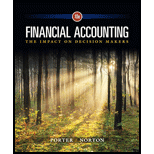
Financial Accounting: The Impact on Decision Makers
10th Edition
ISBN: 9781305654174
Author: Gary A. Porter, Curtis L. Norton
Publisher: Cengage Learning
expand_more
expand_more
format_list_bulleted
Concept explainers
Textbook Question
Chapter 5, Problem 5.2KTQ
Specific identification method
Weighted average cost method
FIFO method
LIFO method
LIFO liquidation
LIFO conformity rule
LIFO reserve
Replacement cost
Inventory profit
Lower-of-cost-or-market (LCM) rule
Inventory turnover ratio
Number of days’ sales in inventory
Moving average (Appendix)
- The name given to an average cost method when a weighted average cost assumption is used with a perpetual inventory system.
- An inventory costing method that assigns the same unit cost to all units available for sale during the period.
- A conservative inventory valuation approach that is an attempt to anticipate declines in the value of inventory before its actual sale.
- An inventory costing method that assigns the most recent costs to ending inventory.
- The current cost of a unit of inventory.
- An inventory costing method that assigns the most recent costs to cost of goods sold.
- A measure of how long it takes to sell inventory.
- The IRS requirement that when LIFO is used on a tax return, it must also be used in reporting income to stockholders.
- An inventory costing method that relies on matching unit costs with the actual units sold.
- The portion of the gross profit that results from holding inventory during a period of rising prices.
- The result of selling more units than are purchased during the period, which can have negative tax consequences if a company is using LIFO.
- The excess of the value of a company’s inventory stated at FIFO over the value stated at LIFO.
- A measure of the number of times inventory is sold during the period.
Expert Solution & Answer
Want to see the full answer?
Check out a sample textbook solution
Students have asked these similar questions
How many units must be sold to reach this profit goal ? General accounting
Subject:-- general accoun
Sub. General accounting
Chapter 5 Solutions
Financial Accounting: The Impact on Decision Makers
Ch. 5 - Merchandise Accounting Merchandise Inventory Raw...Ch. 5 - Inventory Valuation Specific identification method...Ch. 5 - Inventoriable Costs During the first month of...Ch. 5 - Perpetual and Periodic Inventory Systems Following...Ch. 5 - Missing Amounts in Cost of Goods Sold Model For...Ch. 5 - Purchase Discounts For each of the following...Ch. 5 - Working Backward: Gross Profit Ratio Acmes gross...Ch. 5 - Inventory Costing Methods VanderMeer Inc. reported...Ch. 5 - Cost of Goods Sold, FIFO, and LIFO Kramer began...Ch. 5 - Comparison of Inventory Costing Methods—Periodic...
Knowledge Booster
Learn more about
Need a deep-dive on the concept behind this application? Look no further. Learn more about this topic, accounting and related others by exploring similar questions and additional content below.Similar questions
arrow_back_ios
SEE MORE QUESTIONS
arrow_forward_ios
Recommended textbooks for you
 Financial Accounting: The Impact on Decision Make...AccountingISBN:9781305654174Author:Gary A. Porter, Curtis L. NortonPublisher:Cengage Learning
Financial Accounting: The Impact on Decision Make...AccountingISBN:9781305654174Author:Gary A. Porter, Curtis L. NortonPublisher:Cengage Learning Intermediate Accounting: Reporting And AnalysisAccountingISBN:9781337788281Author:James M. Wahlen, Jefferson P. Jones, Donald PagachPublisher:Cengage Learning
Intermediate Accounting: Reporting And AnalysisAccountingISBN:9781337788281Author:James M. Wahlen, Jefferson P. Jones, Donald PagachPublisher:Cengage Learning Financial Reporting, Financial Statement Analysis...FinanceISBN:9781285190907Author:James M. Wahlen, Stephen P. Baginski, Mark BradshawPublisher:Cengage Learning
Financial Reporting, Financial Statement Analysis...FinanceISBN:9781285190907Author:James M. Wahlen, Stephen P. Baginski, Mark BradshawPublisher:Cengage Learning- Principles of Accounting Volume 1AccountingISBN:9781947172685Author:OpenStaxPublisher:OpenStax College
 Cornerstones of Financial AccountingAccountingISBN:9781337690881Author:Jay Rich, Jeff JonesPublisher:Cengage Learning
Cornerstones of Financial AccountingAccountingISBN:9781337690881Author:Jay Rich, Jeff JonesPublisher:Cengage Learning Financial And Managerial AccountingAccountingISBN:9781337902663Author:WARREN, Carl S.Publisher:Cengage Learning,
Financial And Managerial AccountingAccountingISBN:9781337902663Author:WARREN, Carl S.Publisher:Cengage Learning,

Financial Accounting: The Impact on Decision Make...
Accounting
ISBN:9781305654174
Author:Gary A. Porter, Curtis L. Norton
Publisher:Cengage Learning

Intermediate Accounting: Reporting And Analysis
Accounting
ISBN:9781337788281
Author:James M. Wahlen, Jefferson P. Jones, Donald Pagach
Publisher:Cengage Learning

Financial Reporting, Financial Statement Analysis...
Finance
ISBN:9781285190907
Author:James M. Wahlen, Stephen P. Baginski, Mark Bradshaw
Publisher:Cengage Learning

Principles of Accounting Volume 1
Accounting
ISBN:9781947172685
Author:OpenStax
Publisher:OpenStax College

Cornerstones of Financial Accounting
Accounting
ISBN:9781337690881
Author:Jay Rich, Jeff Jones
Publisher:Cengage Learning

Financial And Managerial Accounting
Accounting
ISBN:9781337902663
Author:WARREN, Carl S.
Publisher:Cengage Learning,
Chapter 6 Merchandise Inventory; Author: Vicki Stewart;https://www.youtube.com/watch?v=DnrcQLD2yKU;License: Standard YouTube License, CC-BY
Accounting for Merchandising Operations Recording Purchases of Merchandise; Author: Socrat Ghadban;https://www.youtube.com/watch?v=iQp5UoYpG20;License: Standard Youtube License